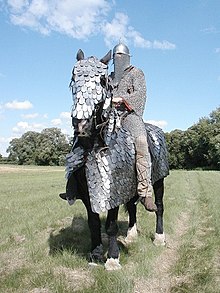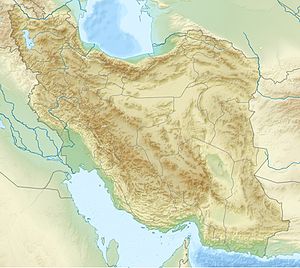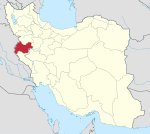Taq-e Bostan
| Taq-e Bostan | |
|---|---|
 Taq Bostan, a famous rock relief of Sassanid Iran | |
| Location | Kermanshah, Iran |
| Built | ca. 4th century CE |
| Architectural style(s) | Persian architecture |

Taq-e Bostan (Persian: طاقبستان, Kurdish: تاق وەسان, lit. 'Arch of stone')[1] is a site with a series of large rock reliefs from the era of the Sassanid Empire of Persia (Iran), carved around the 4th century CE.
This example of Persian Sassanid art is located 5 km from the city center of Kermanshah. It is located in the heart of the Zagros Mountains, where it has endured almost 1,700 years of wind and rain. Originally, several natural springs were visible next to and below the reliefs and arches, some of which are now covered. Springs next to the reliefs still feed a large basin in front of the rock. The site has been turned into an archaeological park and a series of late Sassanian and Islamic column capitals have been brought together (some found at Taq Bostan, others at Mount Behistun and Kermanshah).
The carvings, some of the finest and best-preserved examples of Persian sculpture under the Sassanids, include representations of the investitures of Ardashir II (379–383) and Shapur III (383–388). Like other Sassanid symbols, Taq-e Bostan, and its relief patterns accentuate power, religious tendencies, glory, honor, the vastness of the court, game and fighting spirit, festivity, joy, and rejoicing.
Sassanid kings chose a beautiful setting for their rock reliefs along a historic Silk Road caravan route waypoint and campground. The reliefs are adjacent to sacred springs that empty into a large reflecting pool at the base of a mountain cliff.
Taq-e Bostan and its rock relief are one of the 30 surviving Sassanid relics of the Zagros mountains. According to Arthur Pope, the founder of the Iranian Art and Archeology Institute in the United States of America, "art was characteristic of the Iranian people and the gift which they endowed the world with."
Description of the rock reliefs
[edit]The Taq-e Bostan complex comprise a rock relief standing on its own and several more reliefs associated with two rock cut arches.
Investiture of Ardashir II
[edit]
The relief panel is approx. 4.07 m wide and 3.9 m high.
Shapur II and Shapur III
[edit]The smaller arch or iwan (Taq-e Bustan II) has, on the upper part of the back wall, two Pahlavi inscriptions identifying two royal figures as Shapur II (Shapur the Great) and his son Shapur III. They are shown facing each other. The arch's vestibule measures 6 x 5 x 3.6 meters. It has been suggested as having been built during the reign of Shapur III and some put the date of its completion at 385 AD. However, the royal crown of Shapur III does not agree with those on his coins and is closer to that of his predecessor Ardashir II. It has been argued that the texts represent an usurpation of Ardashir's relief by Shapur III. The translation of the inscriptions follows:
Shapur II inscription :
- This is the figure of Mazda-worshipping Lord Shapur, the king of kings of Iran and Aniran, whose race is from the Gods. Son of Mazda-worshipping Lord Hormizd, the king of kings of Iran and Aniran, whose race is from the Gods, grandson of Lord Nersi, the Shahanshah (king of kings).
Shapur III inscription:
- This is the figure of Mazda-worshipping Lord Shapur, the king of kings of Iran and Aniran, whose race is from the Gods. Son of Mazda-worshipping Lord Shapur, the king of kings of Iran and Aniran, whose race is from the Gods, grandson of Lord Hormizd, the king of kings.

Iwan of Khusrow II
[edit]
The three figures on the back wall of the large iwan are usually considered to represent Khusrow II flanked by Ahura Mazda and Anahita.
Scene of boar and deer hunting
[edit]
There are two hunting scenes on each side of the ivan.
Dowlatshah Relief
[edit]Jumping 1300 years in time the upper relief shows the 19th century Qajar Governor in Kermanshah city, Dowlatshah carving a relief in a big arch.

Taq-e Bostan Photos
[edit]-
Female musicians accompanying king during hunting
-
Capital of a Sasanian column in Taq-e Bostan complex with geometrical design
-
Head part of a column with figural decoration of a Sasanian king
-
Details from a Sassanid relief on the incoronation of Ardashir showing a defeated Julian.
-
relief of Fath Ali Shah, the Qajar king, added to the ancient complex in the 19th century.
-
Relief of Khusrow II
-
Relief of Elaheh (Angel)
-
Statue of Ardeshir II
-
Capital of Khusrow
See also
[edit]- Taq Kasra
- Taq-e Gara
- Sassanid architecture
- Naghsh-e Rajab
- Naqsh-e Rustam
- Bishapur
- List of colossal sculptures in situ
References
[edit]- ^ "Which one is correct, Taq bostan or Taq va san?". IRNA (in Persian). 2 March 2010.
...in Kermanshahi Kurdish, 'san' means stone and the origin of this name came from stony arches
- ^ Nickel, Helmut. "About the Sword of the Huns and the "Urepos" of the Steppes" (PDF). The Metropolitan Journal. 7 (1973). The Metropolitan Museum: 131–134, note 3 – via JSTOR.
- Dr. Ali Akbar Sarfaraz, Dr. Bahman Firuzmandi "Mad, Hakhamanishi, Ashkani, Sasani" Marlik, 1996. ISBN 964-90495-1-7
- Gardeshgary magazine Vol. 13, September 2002
- Iranian Cultural News Agency (CHN)
- Bruno Overlaet, Ardashir II or Shapur III?: reflections on the identity of a king in the smaller grotto at Taq-i Bustan, IRANICA ANTIQUA 46, 2011, p. 235-250 Ardashir II or Shapur III? Reflections on the Identity of a King in the Smaller Grotto at Taq-i Bustan, Iranica Antiqua 46, 2011, 235 – 250
- Bruno Overlaet, Ahura Mazda or Shapur II? A Note on Taq-i Bustan I, the Investiture of Ardashir II (379-383), Iranica Antiqua 47, 2012, p. 133-151 Ahura Mazda or Shapur II? A Note on Taq-i Bustan I, the Investiture of Ardashir II (379-383), Iranica Antiqua 47, 2012, 133 - 151
- Bruno Overlaet, And Man Created God? Kings, Priests and Gods on Sasanian Investiture Reliefs. Iranica Antiqua 48, 2013, 313-354. And Man Created God? Kings, Priests and Gods on Sasanian Investiture Reliefs. Iranica Antiqua 48, 2013, 313-354.
External links
[edit]- Ernst Herzfeld Papers, Series 5: Drawings and Maps, Records of Taq-e Bostan Site Collections Search Center, S.I.R.I.S., Smithsonian Institution, Washington, D.C.
- Photos of Taq-e Bostan
- Taq Bostan (Video)
- Kermanshah and Taq-e Bostan











